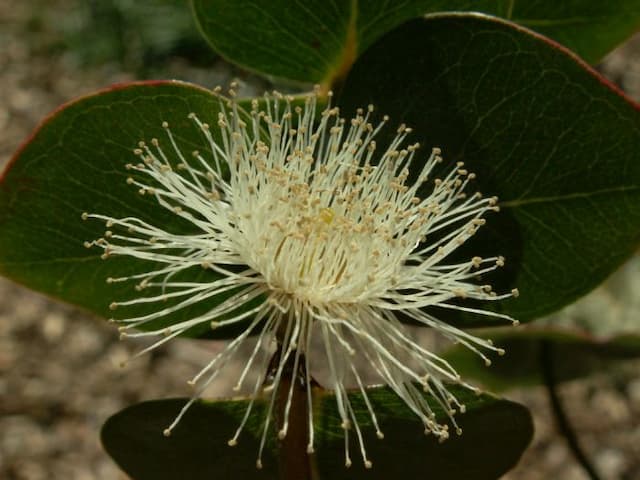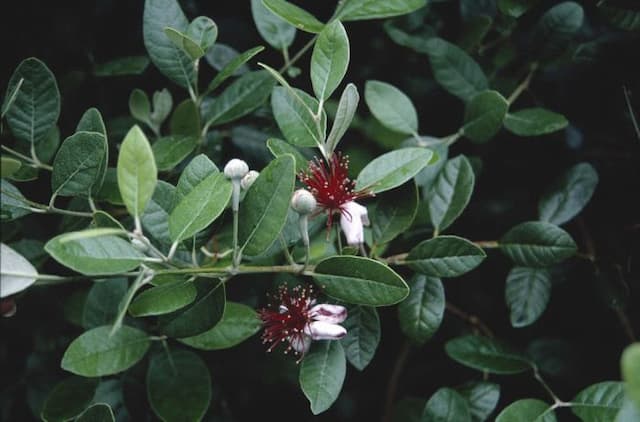New Zealand Tea Tree Leptospermum scoparium 'Nichollsii Nanum'

ABOUT
The Leptospermum scoparium 'Nichollsii Nanum', commonly known as the Dwarf New Zealand Tea Tree, is a compact evergreen shrub. It is characterized by its dense branching and a fine, intricate texture given by its small, needle-like leaves. The leaves are typically a dark green, which contrast beautifully with the profusion of white or pink, sometimes double, cup-shaped flowers that adorn the plant. These blossoms, which boast a delicate appearance, often appear in late winter to early summer and may attract bees. The overall form of the Dwarf New Zealand Tea Tree is rounded and neat, making it a favored choice for ornamental purposes in gardens where its rich foliage and charming flowers can be displayed to full effect.
About this plant
 Names
NamesFamily
Myrtaceae.
Synonyms
New Zealand Tea Tree, Manuka, Dwarf Red Tea Myrtle, Kiwi Tea Tree.
Common names
Leptospermum scoparium 'Nichollsii Nanum'.
 Toxicity
ToxicityTo humans
The Manuka plant is generally considered non-toxic to humans. There are no well-documented cases of poisoning from ingesting any part of this plant. As with many plants, individual allergies or sensitivities are always possible, but Manuka is not known for being hazardous when touched or ingested in normal quantities.
To pets
The Manuka plant is also generally considered non-toxic to pets. It does not contain any known toxic compounds that would typically pose a risk to animals such as cats, dogs, or horses. As with any non-food plant, ingestion of large amounts could potentially cause mild stomach upset, but the plant is not known for being dangerous to pets. It is always wise, however, to prevent pets from ingesting plants as individual animals may react differently.
 Characteristics
CharacteristicsLife cycle
Perennials
Foliage type
Evergreen
Color of leaves
Green
Flower color
Pink
Height
3 feet [0.91 meters]
Spread
3 feet [0.91 meters]
Plant type
Shrub
Hardiness zones
9
Native area
Australia New Zealand
Benefits
 General Benefits
General Benefits- Aesthetic appeal: Leptospermum scoparium 'Nichollsii Nanum', commonly known as Dwarf New Zealand Tea Tree, has a compact growth habit and vibrant pink flowers that add visual interest to gardens.
- Low maintenance: This plant's small size and slow-growing nature make it easy to care for, requiring minimal pruning and upkeep.
- Drought tolerance: Once established, Dwarf New Zealand Tea Tree is resistant to drought, making it ideal for landscapes in arid climates.
- Attracts pollinators: The bright flowers are attractive to bees and other pollinating insects, promoting biodiversity in the garden.
- Evergreen foliage: Its evergreen leaves provide year-round greenery and structure in garden designs and landscapes.
- Deer resistance: The plant is known to be resistant to deer, reducing the risk of damage from wildlife grazing.
- Wind tolerance: Dwarf New Zealand Tea Tree can withstand windy conditions, making it suitable for coastal and exposed sites.
- Soil adaptability: It can grow in a range of soil types, although it prefers well-drained soils, demonstrating good adaptability to different gardening conditions.
 Medical Properties
Medical Properties- Antibacterial: The honey derived from Leptospermum scoparium, commonly known as Manuka, has been shown to possess antibacterial properties, particularly against antibiotic-resistant strains.
- Anti-inflammatory: Manuka honey has been traditionally used to reduce inflammation and assist in the healing of minor wounds and burns.
- Antioxidant: The plant may contain compounds with antioxidant properties, contributing to overall skin health and wound repair.
- Antiviral: Some research suggests that Manuka honey may have antiviral effects.
- Gastrointestinal health: Manuka honey has been used traditionally to soothe the digestive tract and assist with gastrointestinal issues.
- Dental health: There is evidence suggesting that Manuka honey can inhibit the growth of harmful oral bacteria associated with plaque formation, gum inflammation, and tooth decay.
 Air-purifying Qualities
Air-purifying QualitiesThis plant is not specifically known for air purifying qualities.
 Other Uses
Other Uses- Leptospermum scoparium 'Nichollsii Nanum', commonly known as Dwarf New Zealand Tea Tree, can be used as a natural insect repellent when its leaves are crushed and applied to the skin.
- The dried leaves and flowers of the Dwarf New Zealand Tea Tree are sometimes used in potpourri blends for their pleasant scent and preservative qualities.
- Wood from the Dwarf New Zealand Tea Tree can be fashioned into small, decorative items or used in woodturning projects due to its firm texture and attractive grain.
- Beekeepers sometimes plant Dwarf New Zealand Tea Trees near hives as they produce an abundance of flowers, which are excellent for bees and can contribute to a unique flavor in honey.
- The essential oils extracted from the Dwarf New Zealand Tea Tree can be used in aromatherapy to create calming or invigorating atmospheres, depending on the blend.
- The fibrous bark of the Dwarf New Zealand Tea Tree can be used in certain traditional textile practices, such as for weaving mats or creating other fabric-like materials.
- As a compact ornamental plant, it can be used in model landscapes or miniature gardens, providing an authentic and scaled-down representation of natural scenery.
- The fine, small leaves of the Dwarf New Zealand Tea Tree are sometimes used as natural confetti at outdoor celebrations, providing a biodegradable alternative to synthetic varieties.
- Its dense growing habit allows it to be used in natural fencing or privacy screens, and it can be pruned to maintain a specific shape or boundary.
- Due to its resilience and tolerance of a variety of conditions, the Dwarf New Zealand Tea Tree can be used for erosion control in coastal or windswept landscapes.
Interesting Facts
 Feng Shui
Feng ShuiThe Manuka is not used in Feng Shui practice.
 Zodiac Sign Compitability
Zodiac Sign CompitabilityThe Manuka is not used in astrology practice.
 Plant Symbolism
Plant Symbolism- Resilience - The Leptospermum scoparium, commonly known as Manuka, is known for its hardiness and ability to thrive in tough environmental conditions, symbolizing resilience and the ability to overcome challenges.
- Healing - Manuka honey, derived from the Manuka flower, is famous for its medicinal properties, making the plant a symbol of healing and wellness.
- Protection - With its dense growth and antibacterial properties, the Manuka is also a symbol of protection, guarding against both physical and spiritual harm.
- Rarity - As a plant with unique properties, especially in its premium honey production, Manuka stands for rarity and preciousness.
- Purity - The white flowers of the Manuka plant symbolize purity and innocence, often associated with the untouched beauty of nature in New Zealand where the plant is indigenous.
- Peace - The Manuka has a calming presence in many natural settings, representing peace and tranquility.
 Water
WaterThe New Zealand tea tree, or 'Nichollsii Nanum', should be watered deeply and allowed to dry out somewhat between waterings. In general, one inch of water per week is sufficient, but this can vary depending on climate and soil conditions. During hot summer months or in dry climates, you might need to water twice a week; ensure the top couple of inches of soil are dry before re-watering. In winter or cooler weather, reduce watering to once every two weeks or less, as the plant requires less moisture during dormant periods. Always water at the base of the plant to avoid wetting the foliage, as damp leaves can lead to fungal diseases.
 Light
LightThe New Zealand tea tree thrives in full sun but can tolerate some partial shade. For optimal growth and flowering, plant it in a location where it can receive at least six hours of direct sunlight daily. Avoid deep shade, as this can affect the health and blooming of the plant.
 Temperature
TemperatureThe New Zealand tea tree does best in temperatures between 65 to 75 degrees Fahrenheit but can tolerate a range from around 50 to 80 degrees Fahrenheit. It's hardy and can survive brief cold snaps down to about 20 degrees Fahrenheit but should be protected from prolonged freezing temperatures to prevent damage.
 Pruning
PruningFor the New Zealand tea tree, pruning can help maintain its shape and encourage bushier growth. Prune lightly in the spring after the last frost date to remove dead or weak branches, and shape the plant as desired. Pruning too often or too heavily can harm the plant, so it's best to prune no more than once per year unless removing dead or damaged wood.
 Cleaning
CleaningAs needed
 Soil
SoilNew Zealand Tea Tree (Leptospermum scoparium 'Nichollsii Nanum') prefers a well-draining soil mix with a slightly acidic to neutral pH, typically around 5.5 to 7.5. A good mix would be equal parts of peat, coarse sand or perlite, and loamy compost to provide adequate aeration and moisture retention. Ensure good drainage to prevent root rot and occasional replenishment with a balanced, slow-release fertilizer during the growing season.
 Repotting
RepottingNew Zealand Tea Tree should be repotted every 2-3 years to prevent root-bound conditions and to refresh the soil. Repot in spring or early summer into a slightly larger pot with fresh soil mix as described earlier, ensuring the root system is not overly disturbed during the process.
 Humidity & Misting
Humidity & MistingNew Zealand Tea Tree thrives in moderate humidity levels, although it can tolerate a range of conditions. Aim for humidity levels between 40% and 60% for optimal growth. Avoid excessively dry air which may cause stress and leaf drop, while also being cautious of overly humid conditions which can encourage fungal issues.
 Suitable locations
Suitable locationsIndoor
Place in bright, indirect light and avoid overwatering.
Outdoor
Full sun, protect from frost, well-draining soil.
Hardiness zone
9-11 USDA
 Life cycle
Life cycleThe Leptospermum scoparium 'Nichollsii Nanum', commonly known as Dwarf New Zealand Tea Tree, begins its life cycle as a seed, which after germination, develops into a seedling. As the seedling grows, it enters the vegetative stage, characterized by the development of a compact, bushy form, with tiny, aromatic, needle-like green leaves. The plant then matures and enters the flowering stage, producing small, dense, double flowers that are typically dark red, attracting pollinators such as bees. After pollination, the flowers develop into woody capsules which eventually release seeds, completing the reproductive cycle. The Dwarf New Zealand Tea Tree is relatively slow-growing and can take several years to reach its mature size of about 50 cm tall and wide. With proper care, the Dwarf New Zealand Tea Tree can have a long lifespan, often living for several decades.
 Propogation
PropogationPropogation time
Spring to Early Summer
Propogation: The most popular method of propagating Leptospermum scoparium 'Nichollsii Nanum', commonly known as the New Zealand Tea Tree, is through semi-hardwood cuttings. This typically takes place during the summer months when the plant's growth is most active. To propagate, a cutting of about 4 to 6 inches (approximately 10 to 15 centimeters) is taken from a healthy branch, making sure it includes several leaf nodes. The lower leaves are removed and the cut end is often dipped in rooting hormone to encourage root development. The cutting is then placed in a well-draining soil mixture, ensuring at least one or two nodes are buried where roots will form. The environment should be kept humid, often through the use of a plastic cover, and the soil should remain moist but not waterlogged. Rooting can take several weeks, after which the new plant can be gradually acclimatized to less humid conditions and eventually transplanted outdoors.




